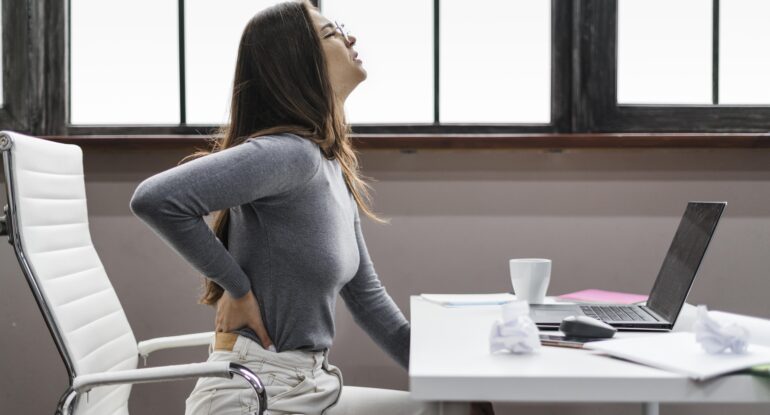Low back pain is a very common complaint, especially among individuals who spend long periods of time in front of the desk and computer. This is because sitting, while being a passive activity, can place stress on several structures of the lumbar spine (lower back). Understanding the underlying mechanisms can help you to develop strategies to mitigate low back pain.
Disc Pressure
When sitting down, particularly in a slouched or forward flexed position, compressive forces are applied across the intervertebral disc. The intervertebral discs are fibrocartilaginous structures that are found between the bones of the spine which acts as a cushion to absorb shock and give the spine flexibility. Under sustained pressure, these discs can degenerate, bulge or herniate, causing back pain.
Muscle imbalance and deconditioning
Prolonged periods of sitting can result in deconditioning and imbalances of the muscles. The hix flexors, particularly the iliopsoas, shortens and tightens in the sitting position. The gluteal and abdominal muscles weaken due to underuse. This imbalance alters the pelvic alignment and can led to back pain.
Reduced blood circulation and Tissue Oxygenation
Prolonged rest results in a reduced blood flow to the paraspinal muscles and intervertebral structures. The reduction of blood flow results in decreased oxygen and nutrient delivery to the back, while at the same time, impairing the removal of metabolic waste. This can lead to muscle fatigue and stiffness, which can cause back pain.
Neuromusclar inhibition
In normal circumstances, the gluteus muscles function as primary stabilizers for the pelvis and hips. Prolonged disuse from extended sitting can lead to a diminished communication between the brain and gluteal muscles. This forces the lumbar spine to compensate for reduced hip stability, leading to overactivation and strain of the paraspinal muscles.
Prevention is better than cure
To reduce back pain from prolonged sitting, try some of these measures:
- Use chairs that support the natural curve of your body
- Take active breaks by implementing regular walks every 30-60 minutes
- Engage in core exercises
- Maintain upright posture with feet flat on the floor, knees at hip level and screens at eye level.
If you develop low back pain, don’t ignore it. It is important to consult a pain specialist to rule out any serious underlying conditions. Early treatment can help to prevent the pain from becoming chronic.


